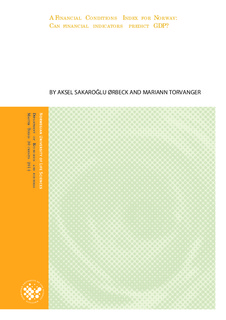A financial conditions index for Norway : Can financial indicators predict GDP?
Master thesis
Permanent lenke
http://hdl.handle.net/11250/187215Utgivelsesdato
2011-10-25Metadata
Vis full innførselSamlinger
- Master's theses (HH) [1072]
Sammendrag
In this thesis, we used financial indicators to construct a Financial Conditions Index (FCI) aimed at predicting Norwegian GDP.
Our analysis started out by surveying previous work on FCIs and leading indicators. The majority of existing FCIs include some measure of interest and exchange rates, asset prices and risk premiums. We followed this consensus, and constructed two sets of single equation log-log regression models with up to four lags; one for each of the five single indicators proven to have leading characteristics in previous
literature, and one for each FCI using an equally weighted sum approach. We then calculated sub-indices for each financial indicator and added the sub-indices together, resulting in five FCIs.
Next, we conducted several out-of-sample predictions of the period 2006(1)-2010(4) based on estimated
weights from the basis period 1980(2)-2005(4). To test our FCI’s forecasting power we examined some
alternative forecasts as benchmarks, five single indicators, a naïve model and FCI predictions by OECD
and Goldman Sachs. To compare the different prediction models’ preciseness, we chose the RMSE and
MAPE measures. The results are contradictory, and dependent on whether RMSE or MAPE is the criterion of selection.
However, neither of the FCIs, nor any of the other single indicators or benchmarks was able to provide consistently superior estimates. None of the models that provide the lowest RMSE or MAPE values are statistically significant, and no model is superior in both criteria. The best FCI model based on RMSE is our static FCI, but chosen on MAPE the best model is the FCI with one lag. We emphasize the RMSE criterion due to the assumptions underlying OLS estimation, and recommend the static FCI. Further
improvement suggestions and future research potential are treated at the end.
